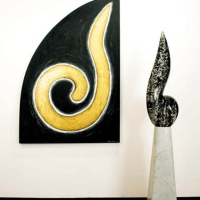29. AKIO MAKIGAWA

Akio Makigawa arrived in Perth from Japan in 1974 with the intention of working as a sail maker. Since boyhood, sailing had been his first love and he dreamt of one day owning a boat to sail around the world. Makigawa had always enjoyed making paintings and working creatively, however he had not thought of making art a career. His first encounter with sculpture was through the Perth sculptor Tony Jones (born 1944) whom he met through a common interest in sailing. He enrolled in the Claremont School of Art which had a focus on the study of sculpture - here he was introduced to the enormous possibilities within the realm of sculpture.
He continued his study of sculpture at the Western Australian Institute of Technology (now Curtin University) and was influenced by the radical attitudes of Terry New and other expatriate British lecturers. Makigawa was drawn to British sculpture more than any other as it was engaged in an attempt to free sculptural form from its dependence on the spatial and emotional logic of the human body.1 Makigawa found inspiration from many Australian and international sculptors, however he began to form his own unique feeling towards sculpture which involved the more profound Japanese attitude to material.
In Japan, the religious thing is tricky: if you find a stone or the air or a tree that is right then it can be close to God. I have an approach that is different to the English honesty to materials. For them material is just material. They are not interested in the spiritual side of material. Even Henry Moores interest in material goes no further.2
In this work, Makigawa has honed Carrara marble to form the tapered plinth and Poltarro marble for the perfectly formed organic curve shape at the top. The contrasting shapes and shades of stone create an energy between the two elements which is complimented by the sail-shaped canvas. The tapering curves and sail shapes are recurring elements in his work and appear throughout the different stages of his oeuvre.
The influence of modernist sculptors Jean Arp (1887-1966) and Constantin Brancusi (1876-1957) is evident, particularly the latters notion of incorporating different materials into one artwork. Here, Makigawa offsets his marble form with the sail-shaped canvas depicting a complimentary curve in gold leaf.
Some highlights from Makigawas impressive career are Time and Tide 1994 near Melbournes Town Hall, created from white Carrara marble, bluestone, stainless steel and fibre optic lighting which illuminates the beautiful smooth and reflective forms at night. Another is Elements and Being 1989, located in the Adelaide Plaza, consisting of five parts each expertly crafted from Carrara white marble and Spanish black marble.
Makigawa is most well-known for his memorable public sculpture commissions, and only a limited amount of his work was available for collectors through solo exhibition. The artists deteriorating health restricted the amount of work he was able to produce outside of his public commissions. Privately owned works are so few, Seer presents a rare opportunity to acquire one of Makigawas unique works.
Footnotes
1. Bromfield, D., Akio Makigawa, Craftsman House, Sydney, 1995, p.9
2. Akio Makigawa, interview with David Bromfield, Perth October 1994, cited ibid. p.9
Caroline Jones BA, MArtAdmin.